I know.
We are in the midst of a lockdown. However, my most read blogs are all around sunscreen. Don’t look at me. I am just the person who wants to be a bit more helpful so that we all get through the insanity of Donald Trump and this God forsaken lockdown.
Methodology
I went to Sephora USA’s website and I filtered as follows:

The best thing about buying sunscreen in the USA, is that legally, sunscreens are OTC (over the counter) drugs and must disclose the following information:
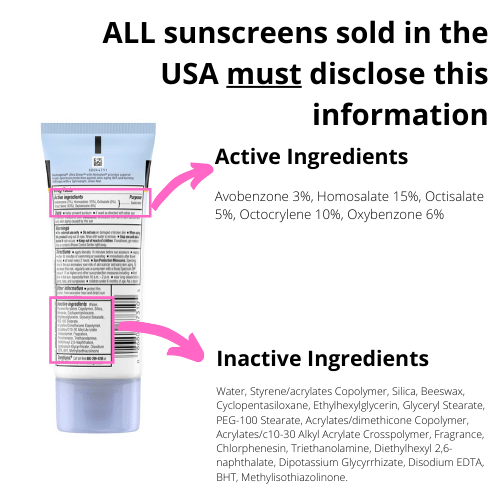
The Active Ingredients are sunscreen filters that are permitted by US law and their quantities. This allows me to use a sunscreen simulator and generate a UVA and UVB absorbance profile for that combination of filters.
Quite frankly, that is where all the good news for today ends.
I did want to write 25 reviews of each American sunscreen in my filtered list – much like I did for Nykaa (see Bestselling sunscreens on Nykaa.com to buy now).
But it was just not worth my effort or your time. I will put separate UVA and UVB absorbance profiles of all sunscreens I filtered, but really 80% of them are not worth buying. There are simply better options at CVS pharmacy.
Instead I am going to share with you a few observations about my review and end with which sunscreens I would buy.
All the data underlying my research can be found in this document at this LINK
What did I learn?
Lesson One: the bulk of sunscreens comply with both US broadspectrum requirements and the stricter European Union (EU) regulatory requirement for UVA protection.
We want sunscreen filters to protect against both UVB and UVA radiation, but especially UVA as most UV radiation is UVAI….

The EU requirement is = one-third of the sunscreen protection goes towards protection against UVA radiation and meets the broadspectrum requirement that the US requires of sunscreen. While both the EU and US test sound similar, the US test is less strict. Therefore, it is comforting that most of the sunscreens I looked at pass both tests.
(If you would like a more detailed explanation please read The Sunscreen reboot: why you should read the Ingredient label of sunscreens)
Lesson Two: most products have low PA ratings
The bulk of the 25 products have a PA rating of PA++.
A PA rating (in non-technical speak) measures something called the Persistent Pigment Darkening caused by UVA which is a measure of the skin darkening that persists 2 hours to 24 hours after the end of UVA exposure.
The PA rating is a label that allows consumers to assess the level of protection the sunscreen offers against UVA radiation.

My conclusion is based on the sunscreen simulation of the actual Active Ingredients in the product. I ignore the effect of any sunscreen booster ingredients in the product (and there are many of these).
For example, this is First Aid Beauty Weightless Mineral SPF 30
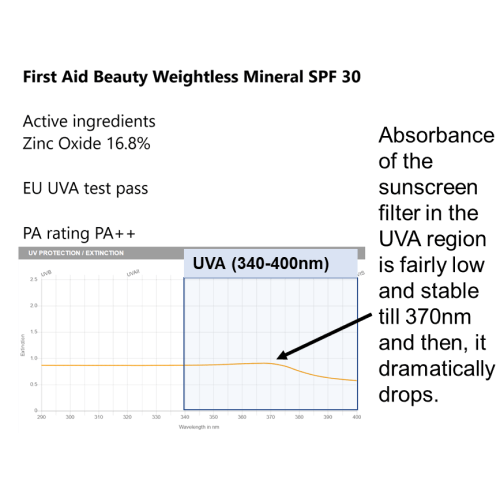
Lesson Three: the products with PA+++ rating are few and far between
This list surprised me. These sunscreens are:
- Supergoop! Glowscreen sunscreen SPF 40
- LANCÔME UV Expert Aquagel Defense Primer & Moisturizer SPF 50
- Supergoop! PLAY Everyday Lotion SPF 50 with Sunflower Extract
- Algenist Sublime Defense Ultra Light Weight UV Defense Fluid SPF 350
- Peter Thomas Roth Max Mineral Naked Broad Spectrum SPF 45
Most products were a PA++ rating, with the exception of Murad Anti-Aging Moisturizer SPF 30, which I would argue is a PA+ rated product.
Lesson Four: trends in sunscreen composition
- There is a shift in the sunscreen filters being used away from Oxybenzone and Octinoxate. I am not surprised about Oxybenzone (see Chemicals to Avoid- Oxybenzone) and was a bit more surprised about Octinoxate. More and more products, use Homosalate, a really weak UVB filter that has a strong track record of safety.
- Unlike CVS pharmacy sunscreens, very few sunscreens use high percentage of Zinc Oxide in their formulation. The only exception is Drunk Elephant at 20% Zinc Oxide. This is a surprise because there is no shortage of mineral sunscreens in my filtered list of 25.
- The sunscreens are full of anti-oxidants and natural moisturising factors. I get this. The action of UV radiation, is to create reactive oxygen species (ROS), which damage our skin and it is in fact a good idea for a sunscreen to have anti-oxidants to “mop” up the ROS. However, I would argue that you should pay a premium NOT for this but for a really fantastic sunscreen that actually does its job of absorbing, reflecting and scattering UV radiation in the first place?
Lesson Five: price unfriendly sunscreens
This is the price branding:
Twenty percent of sunscreens cost less than US$ 0.50/ml

Forty percent of sunscreens cost between US$ 0.50 – US$ 1.00 per ml
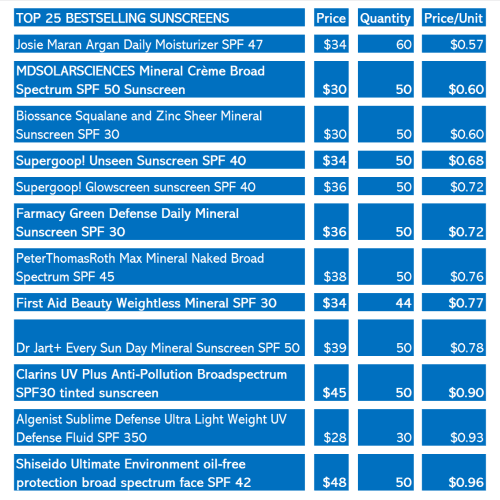
Forty percent of sunscreens cost more than US$ 1.00 per ml

I am cannot explain to you in sensible words how much this pricing offends, as quite frankly the most expensive sunscreens are not at all the best.
Here is the absorbance profile of the most expensive sunscreens: La Mer SPF 50 and Dermalogica SPF 50.
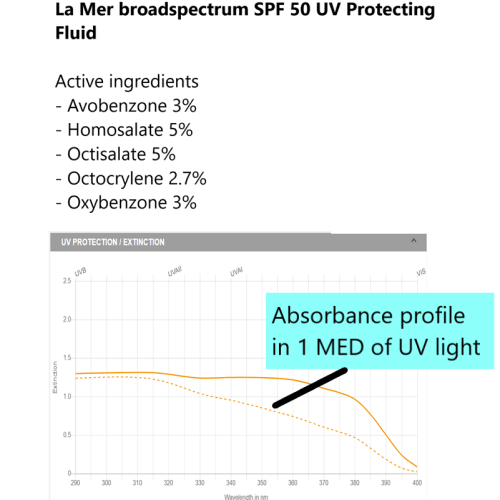
What starts as a stable combination without UV (solid line) quickly breaks down in UV light. This indicates that the combination of filters is not photostable.
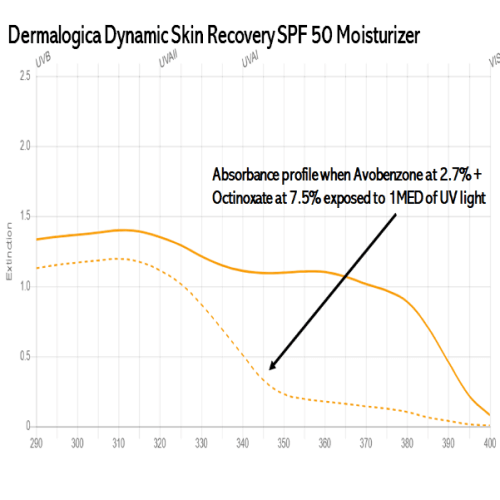
With Dermalogica, clearly we think we are buying broadspectrum coverage, but the key question is this: are you buying broadspectrum and photostable coverage?
Lesson Six: which sunscreens would I buy?
My favourite is Supergoop! Glowscreen Sunscreen SPF 40. SUPERGOOP!
This is the absorbance profile of the product, which shows superior UVA protection to La Mer and Dermalogica. The dotted line shows more absorbance and photostability than the above sunscreens. This is what you expect of a good decent suncreen
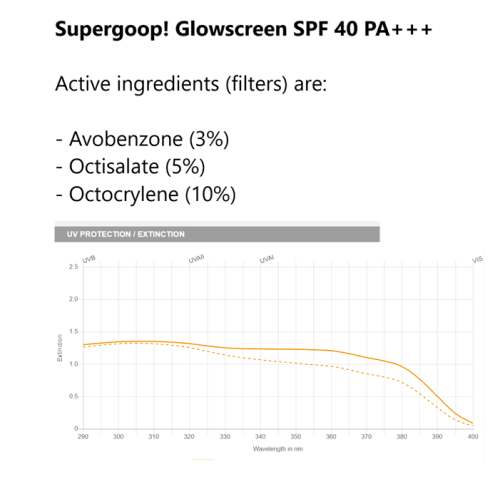
and here is a fancy photo of this sunscreen.
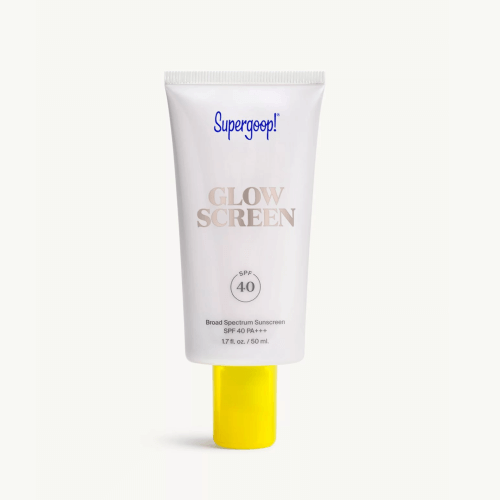
Lesson Seven: CVS pharmacy sells better sunscreen than Sephora?
Last summer I spent several weeks in Manhattan, New York. I wonder if that will ever happen again. But I digress. I was able to spend a lot of time scouring the aisles of a CVS pharmacy on the Upper East side. Hands down CVS pharmacy stocks better sunscreens. I will make a special mention of SunBum Mineral Moisturizing Sunscreen Lotion SPF 50 (20% Zinc Oxide formulation) and CVS Health Zinc Face Sheer Lotion SPF 50 (21.6% Zinc Oxide formulation).

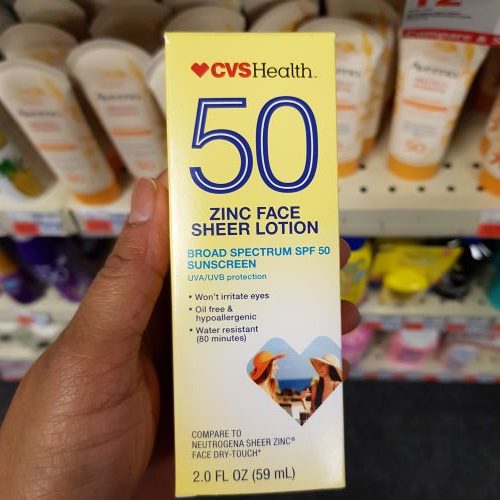
Both provide formidably better protection than most of the sunscreens in today’s blog.
Concluding remarks
I do not like using CC cream or BB cream and the simple reason is I cannot measure out the correct amount. Please read “Do I need to wear sunscreen separate from my foundation?” for more information.
I would love to hear from you, so please drop me a line at email@happyskindays.com about your favourite sunscreen.
*******
COPYRIGHT
I wish to remind some of you that I am a non-affiliated skincare blogger. I invest my time, money, blood, sweat, and tears in creating content for my blog. My blog is read in multiple countries and according to my lawyers, each of those countries protects my content and rights under copyright law. If you would like to use my content, do the right thing, and write to me at email@happyskindays.com. Don’t be that person who steals content, because it’s arrogant, disrespectful, and ultimately, a crime.